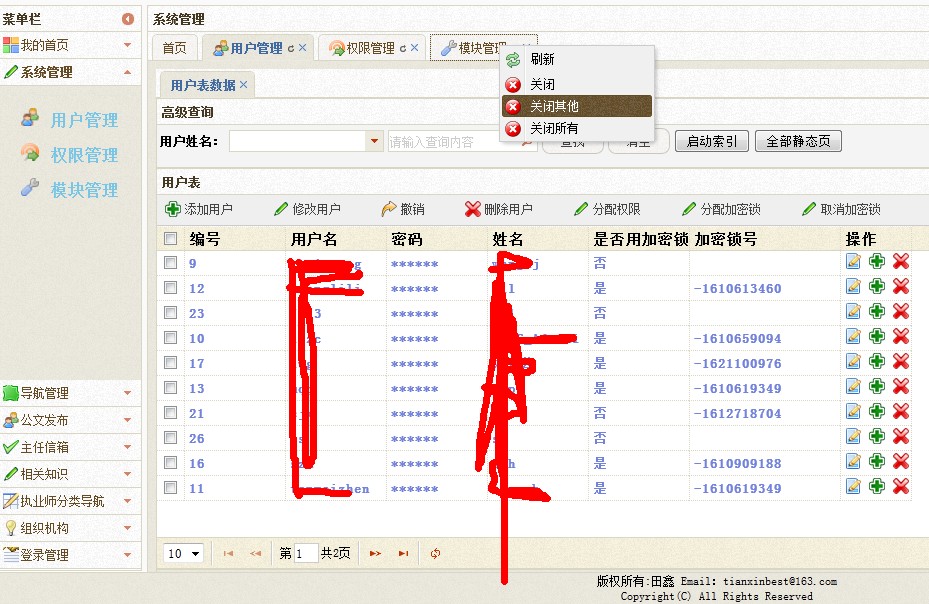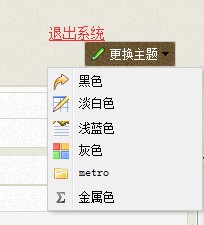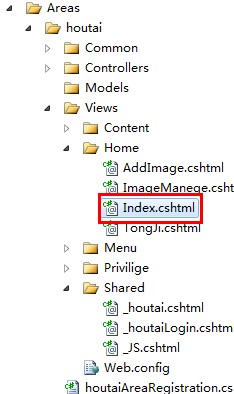一、前言:
1、再看这篇文章的时候,您是否已经完成前两篇介绍的文章里的功能了?(Tabs页的添加,Tabs页右键的关闭,主题的更换)


2、今天来说说登录窗口吧,看截图:是不是在进入的时候左边的菜单栏和中间的Tabs页没有内容(安全起见,必须得这样,只有登录成功后页面才能显示)。
而且还得是后面的内容是不能选择的,用过Jquery-EasyUI的朋友都知道,.dialog中有个Modal设置为True就行。

二、登录窗口功能如何实现?
1、还记的第二篇中说到MVC3中Shared文件夹下边的_houai.cshtml中有个@RenderBody,这个是布局页中必须得有一个,说白了就是一个“坑”,放内容页的地方。
2、所以在进入系统后台的时候,我把这个登录窗口就嵌套在这个布局页当中。文件位置如下:

3、在Index中记得引用布局页:Layout = "~/Areas/houtai/Views/Shared/_houtai.cshtml";
4、Jquery-EasyUI中的Dialog本身也是个DIV,怎么让他渲染成一个Dialog,有两种方式,我用的是写Jquery的方式。
(1)刚进入页面,先让输入用户名的地方进行设置焦点。
(2)AJAX的方式去验证用户名和密码。如果登录成功后,leftTreeLimits()方法判断此用户拥有什么样的权限!该显示哪些内容!这时Dialog窗口应该得关闭。
<script type="text/javascript"> var dialogID; $(function () { $("#name1").focus(); dialogID = $("#dlg").dialog({ closable: false, modal: true, buttons: [ { text: "登录", handler: function () { $.post( "/Account/LogIn", { "UserName":$("#name1").val(), "password":$("#pwdd").val(), }, function(d) { if (d=="yes") {
//菜单项判断此用户所拥有的功能! leftTreeLimits(); $("#dlg").dialog('close'); $.messager.show({msg:"登录成功!",title:"提示"}); $("#bodyColor").css("display", ""); $("#bodyColor1").css("display", ""); } else if (d=="no") { $.messager.alert("提示","用户名和密码错误!"); return;
} } ); } }] }); }); </script>
(3)、body部分当然得有个表单,这个DIV用上面Jquery的方式渲染成一个Dialog,Controller部分,只返回一个View()就行。
@using (Html.BeginForm("", "",FormMethod.Post,new{id="Login"})) { <div id="dlg" title="登录" style="width: 400px; height: 200px; padding: 10px"> <table id="list" style="background-color:#e5e1e5;"> <tr><td>用户名:</td><td><input id="name1" name="name" type="text" class="easyui-validatebox" value="tianxin" required="true" missingMessage="请输入用户名" /></td></tr> <tr><td>密码:</td><td><input id="pwdd" name="password" type="password" class="easyui-validatebox" required="true" width="10px" missingMessage="请输入密码"/></td></tr> </table> </div> }
(4)、通过第(2)个Jquery的代码很容易看出来进入的是哪个页面去判断的用户名和密码,/Account/Login。在这个Action里也得做这几个功能:
1、判断用户名和密码是否正确。
2、窗体的身份验证和登录成功后加入到Cookie中。
3、Model类使用的就是Account中的默认的LogOnModel。
4、FormsAuthenticationTicket第六个重载(user.ID),可以保存这个数据,在Global.asax.cs取到这个数据之后还有惊喜!!(稍后写出来)
private static readonly string UserNameSessionKey = "Name";
public ActionResult LogIn()
{
HttpCookie c = HttpContext.Request.Cookies[UserNameSessionKey];
LogOnModel model = new LogOnModel { UserName = c != null ? c.Value : "" };
return View(model);
}
[HttpPost]
public ActionResult LogIn(LogOnModel model, string returnUrl, string subAction, string subAction2)
{
if (model == null)
{
var m = TempData["User"] as LogOnModel;
if (m != null)
{
model = m;
}
}
if (ModelState.IsValid == false) return View(model);
var user = userBLL.GetByNameAndPassword(model.UserName.Trim(), model.Password.Trim());
if (user==null)
{
return Content("no");
}
{
HttpCookie c = new HttpCookie(UserNameSessionKey,model.UserName);
HttpContext.Response.Cookies.Add(c);
}
//窗体票据的验证
FormsAuthenticationTicket authTicket = new FormsAuthenticationTicket(
1,
user.UserName,
DateTime.Now,
DateTime.Now.AddMinutes(20),
false,
user.ID.ToString(),
"/"
);
HttpCookie cookie = new HttpCookie(
FormsAuthentication.FormsCookieName, FormsAuthentication.Encrypt(authTicket)
);
Response.Cookies.Add(cookie);
if (!String.IsNullOrEmpty(returnUrl))
{
if (returnUrl[0] != '/') returnUrl = "/" + returnUrl;
return Redirect(returnUrl);
}
if (user != null)
{
return Content("yes");
}
else
return Redirect("~/houtai");
}
5、在Global.asax.cs中如何取到前面的那个值??给 MvcApplication 增加构造函数,在其中增加 AuthorizeRequest 事件的处理函数。
public MvcApplication()
{
AuthenticateRequest += new EventHandler(MvcApplication_AuthenticateRequest);
}
void MvcApplication_AuthenticateRequest(object sender, EventArgs e)
{
HttpCookie authCookie = Context.Request.Cookies[FormsAuthentication.FormsCookieName];
if (authCookie != null)
{
FormsAuthenticationTicket authTicket = FormsAuthentication.Decrypt(authCookie.Value);
int userID = int.Parse(authTicket.UserData);
var userPrincipal = new Principal(userID, new GenericIdentity(authTicket.Name), new string[] { });
Context.User = userPrincipal;
}
}
6、上面这段代码有没有看到Pricipal,表示一般用户,以后方便对Controller写个扩展方法,只要在任何的Controller中,使用类似这样:this.User(),就可以获得登陆后的用户,记得不要保存在Session中,将用户保存在 Session 中是一种非常不好的做法。下面就实现Principal.
//实现GenericPrincipal,表示一般用户
public class Principal : GenericPrincipal
{
public int ID { get; set; }
public Principal(int id, IIdentity identity, string[] roles)
: base(identity, roles)
{
this.ID = id;
}
}
7、上面说到扩展方法,来写一个吧,对Controller进行扩展。使用了NHibernate;NHibernate.Linq(Nhibernate中使用Linq查询的方式),扩展方法必须静态的,如果要用的话必须在Web.Config下添加命名空间,或者使用这种“懒”的方式,Using System.Web.MVC。这样的话在任何一个Controller中都可以使用var User=this.User();得到登录的用户的信息了。
public static Users User(this Controller controller) { var principal = controller.User as MvcApplication.Principal; if (principal == null) return null; return GetCurrentSession().Linq<User>() .Where(u => u.ID == principal.ID) .FirstOrDefault(); }
5、上面的登录功能的内容引申的知识点有点多了,个人认为还是详细点好,对于初学者来说看的更清晰一点。验证用户和获得用户就告一段落吧,接下说说,登录成功之后判断左边的菜单项,该显示哪些菜单,这个主要是判断他具有哪些权限?思路:(1)判断完权限之后,返回拥有权限的JSon数据的名称(2)然后和所有的权限(初始化时,所有的权限都在左边菜单栏)进行对比(3)返回的数据如果没有的话,就使用Jquery进行Remove或者Hide掉。剩下的不就是他所拥有的权限了吗。这是我的一种想法。如果还有其他的想法的话,请朋友们留言,也学习一下。
////TX:用户所拥有的权限菜单
function leftTreeLimits()
{
$.post("/houtai/Privilige/PrivigeLimit",{},function(data){
if (data!=null&&data!=undefined) {
var node=$(".panel p a");
$.each(data,function(a,b){
for (var i = 0; i < node.length; i++) {
if($(node[i]).text()==b)
{
$(node[i]).parent().remove();
}
}
});
var parentNo=$("#accordionId .panel");
for (var j = 0; j < parentNo.length; j++) {
if ($(parentNo[j]).children("#MenuID").children("p").length==0) {
$(parentNo[j]).hide();
}
}
}
});
}
6、上面的JS很清晰,导向了/houtai/Privilige/PrivigeLimit,返回的是JSon数据,然后遍历他的Name,进行比较。删除没有权限的名称。
//进入系统菜单权限分配
public JsonResult PrivigeLimit()
{
var user = this.User();
if (user == null)
{
return Json(null);
}
return Json(userLimitBll.GetLimits(user.ID));
}
三、总结:登录功能已经完成,涉及到的知识点挺多的,也说了说思路,说的应该挺清晰的吧。如果对您有帮助,请继续关注这个系列吧,帮忙点击右下角“推荐”,让更多的朋友来共同学习,共同进步!!